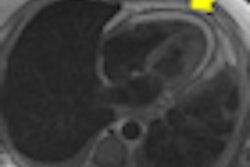Diffusion-weighted MR imaging (DWI-MRI) and apparent diffusion coefficient (ADC) maps have demonstrated their value in improving the accuracy of breast MRI at 1.5 tesla compared to conventional scanning protocols. But do these techniques also work at 3 tesla?
The answer is yes, according to a study in the July issue of Radiology. Results indicate that ADC maps generated by DWI scans performed on 3-tesla MRI magnets improve the ability to characterize breast lesions compared to conventional T1-weighted and dynamic contrast-enhanced breast MRI studies.
What's more, researchers at the U.S. National Institutes of Health (NIH) in Bethesda, MD, developed a method to further improve the accuracy of ADC maps by "normalizing" scans to glandular tissue, further reducing breast MRI's notoriously pesky false-positive rate (Radiology, July 2010, Vol. 256:1, pp. 64-73).
ADC mapping measures the magnitude of the diffusion of water molecules within the tissue being imaged. Previous research has demonstrated that malignant and benign breast tissues produce differences in ADC maps on 1.5-tesla scans. The authors of the new study, led by Riham El Khouli, MD, wanted to see if the phenomenon also occurred at 3 tesla, yielding improved signal-to-noise ratios.
They also wanted to see if they could improve the value of ADC maps through a "normalization" technique.
"Due to the variation in water content of the breast across the menstrual cycle, we investigated a way to normalize the apparent diffusion coefficient values, which are the quantitative analysis of the DWI," El Khouli told AuntMinnie.com. "This approach resulted in improving the diagnostic performance of DWI-MRI of the breast and increasing its incremental value when added to the conventional breast MRI."
The study included 93 women, of which 41 (44%) were premenopausal and 52 (56%) were postmenopausal. All of the women had undergone 3D high-spatial-resolution T1-weighted contrast-enhanced MRI, dynamic contrast-enhanced MR, and DWI exams at 3 tesla. Each of the women in the study had received either a pathologic analysis-proven diagnosis (96 lesions) or had had lesion stability confirmed at more than two years of follow-up (five lesions). Of the 101 lesions found in the study cohort, 33 (32.7%) were benign and 68 (67.3%) were malignant.
All patients were imaged with a 3-tesla clinical MR system (Achieva 3.0T, Philips Healthcare, Andover, MA) with a bilateral, dedicated four-channel breast coil (Invivo, Orlando, FL).
Use of the normalized ADC data led to reduced overlap between benign and malignant lesions: With absolute ADC data, 60 out of 85 lesions overlapped, compared to only 14 of 85 overlapping lesions with the normalized ADC maps. As well, the area under the receiver operator characteristics curve (AUC) improved from 0.89 to 0.98, and the false-positive rate decreased from 36% (nine of 25 lesions) to 24% (six of 25 lesions).
Adding DWI-MRI analysis to a conventional breast MRI protocol significantly improves the diagnostic performance of breast MRI for lesion characterization at the 3-tesla field strength, El Khouli said. And this is good news for women, because it may improve clinicians' ability to discriminate benign versus malignant breast lesions in vivo and, therefore, decrease the number of the unnecessary biopsies.
"The suspicion of breast cancer, as well as its workup, puts extra burden on the patient and her family," El Khouli said. "And biopsy is an invasive diagnostic technique. Increasing our ability to exclude benign lesions with a noninvasive technique would improve the quality of life of patients with mammographically suspicious breast lesions."
By Kate Madden Yee
AuntMinnie.com staff writer
June 24, 2010
Related Reading
Lesions 'probably benign' on breast MRI may not need biopsy, May 27, 2010
Diffusion-weighted MRI in acute stroke: Stronger is not always better, May 24, 2010
Whole-body MRI workup finds common breast metastases, May 11, 2010
Breast MRI improves cancer staging for newly diagnosed women, May 3, 2010
Resting fMRI exam may predict stroke and brain injury outcomes, March 30, 2010
Copyright © 2010 AuntMinnie.com



















